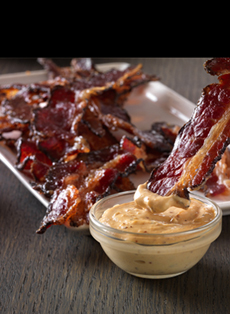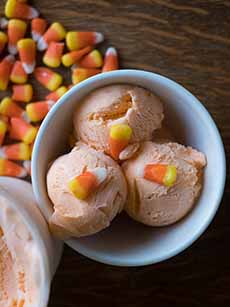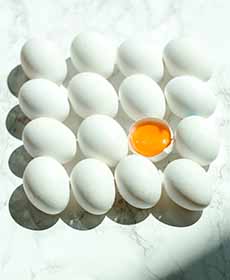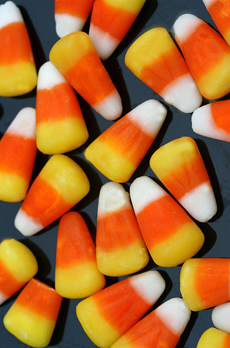|

[1] Two types of Balsamic Vinegar of Modena you should know: regular and invecchiato, which is aged in barrels for three years or more (all photos © Balsamic Vinegar Of Modena).
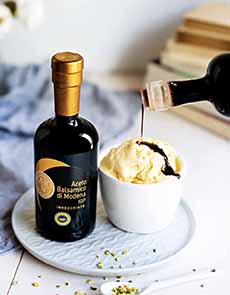
[2] There are several uses for balsamic below, but one you might not have thought of is on ice cream!

[3] The EU’s Protected Geographic Indication seal (PGI) assures that you are buying authentic Balsamic Vinegar of Modena.

[4] As balsamic vinegar ages, it becomes thicker and more concentrated.
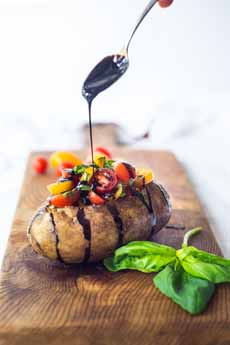
[5] Spruce up a baked potato with balsamic-marinated cherry tomatoes. Here’s the recipe (photo © Idaho Potato Commission).
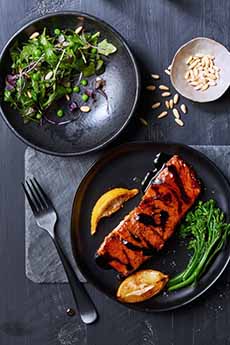
[6] Balsamic glazed salmon. Here’s the recipe, and more about how to use balsamic glaze (photo © DeLallo).
|
|
The Consorzio Aceto Balsamico di Modena (Consortium of Balsamic Vinegar of Modena) has declared a new food holiday: November 1st Balsamic Vinegar of Modena Day.
Balsamic vinegar is one the most important Italian food products—and also one of the most knocked-off.
There is a lot of balsamic vinegar sold that is imitation balsamic. It hasn’t been made according to the rules and regulations of the Consorzio
Some inexpensive supermarket or big chain balsamics are simply cheap red wine vinegar colored and flavored with caramel.
If it’s inexpensive, it’s imitation!
With so many bottles on the shelves, it’s not always easy to locate the authentic Balsamic Vinegar of Modena. be To certain:
Check for the EU’s Protected Geographic Indication logo (PGI) on the bottle (photo #3).
In Italian, the acronym is IGP, Indicazione Geografica Protetta.
The things to look out for follow, but first:
> Here’s more about imitation balsamic.
> The different types of balsamic vinegar.
> The different types of vinegar: a photo glossary.
> The history of vinegar.
Below:
> The history of balsamic vinegar.
> Favorite ways to use balsamic vinegar.
> The year’s 6 vinegar holidays.
WHAT IS AUTHENTIC BALSAMIC VINEGAR
Today, the authentic balsamic vinegar of Modena, Italy—Aceto Balsamico di Modena—is still made under the same very strict conditions that have guided it for centuries.
Balsamic Vinegar of Modena specifications require that:
The raw materials (grapes), processing, maturation and aging must take place in the provinces of Modena and Reggio Emilia.
The grape musts come from seven specific varieties of grapes: Lambrusco, Sangiovese, Trebbiano, Albana, Ancellotta, Fortana and Montuni. These grapes have just the right concentrations of sugar and acidity.
Wine vinegar, a minimum of 10%, is added to the must, along with some aged vinegar that is at least 10 years old.
Next, a minimum 60-day maturation period takes place in barrels, vats or casks. These containers must be made from specific precious woods: Chestnut, Mulberry, Sessile Oak or Juniper.
After 60 days the balsamic can be bottled and released (photo #1). But it can continue to age.
If the maturation phase in the barrels lasts more than three years, the finished product is classified as (invecchiato, aged.
If the product is aged for 3 years or more it is labeled “invecchiato” (aged).
But that’s not all! In order for the product to be certified as Balsamic Vinegar of Modena, analytic and organoleptic tests by expert technicians and tasters are performed on the vinegar while it’s still in barrels.
If it passes the test finished product is then packaged into glass, wooden, ceramic or terracotta containers of varying sizes. The European logo of the “Protected Geographical Indication” guarantees the authenticity of the product to the consumers.
BEYOND INVECCHIATO
The oldest and most complex balsamics are the “traditional” balsamics, Aceto Balsamico Tradizionale di Modena. These are aged for a minimum of 12 years. Extra Vecchio (Extra Old) balsamics are aged for a minimum of 25 years.
The older they get, the more the vinegar evaporates in the barrel, the more concentrated and syrupy the vinegars becomes. You can find balsamics aged 50, 75 years, and older, costing hundreds of dollars for just 3.4 ounces.
These precious balsamics are not used in cooking, but as garnishes: dribbled by the drop onto Parmigiano-Reggiano or other fine cheese, foie gras, seafood, ice cream…or as a digestif at the end of the meal, served on a little spoon.
FAVORITE USES FOR BALSAMIC VINEGAR
Whether invecchiato or younger, any balsamic can be used in:
Braises (for depth of flavor)
Cocktails (try this Balsamic Negroni)
Drizzles (garnishes for meat, poultry and fish/seafood, even ice cream with balsamic [photo #2])
Glazes, both sweet and savory (here’s more about balsamic glaze)
Marinades (for depth of flavor)
Pan Sauces (ditto—how to deglaze a pan)
Soups (ditto)
Vinaigrettes
Splashes—add a splash of balsamic to just about anything, from charcuterie and white pizzas to risotto to strawberries, fruit tarts and savory tarts
Here’s more about each of these uses.

[7] Caprese flatbread with balsamic glaze. Here’s the recipe (photo © For The Love Of Cooking).
|
THE HISTORY OF BALSAMIC VINEGAR
Balsamic Vinegar of Modena’s origin dates back to ancient Rome, when grape must* was cooked down into a syrup used as a sweetener and condiment—and as a medicine, too.
Production of balsamic vinegar became linked with the Italian city of Modena during the 11th century.
Toward the end of the 13th century, the art of vinegar production was cultivated at the court of the Dukes of Este in Modena. But it was not until 1747 that the adjective “balsamic” appeared in the registers of the cellars of the dukes.
In the 19th century, Balsamic Vinegar of Modena became known and appreciated abroad.
Since then, the bitter-sweet balanced flavor, with its intense deep brown color and luscious aroma, has become a favorite with connoisseurs worldwide.
Here’s more of the history of balsamic vinegar.
Here’s more about how balsamic vinegar is made.
THE YEAR’S 6 VINEGAR HOLIDAYS
May: National Vinegar Month
June, 1st Friday: National Fish And Chips Day
June 16: National Vinegar Day†
September 23: National Apple Cider Vinegar Day
November 1: National Balsamic Vinegar Of Modena Day
November 1: National Vinegar Day†
Plus:
The year’s 9 pickle holidays
March: National Sauce Month
________________
*Grape must (from the Latin vinum mustum, young wine ) is freshly crushed grape juice that contains the skins, seeds, and stems of the fruit.
†There are two National Vinegar Days. June 16th is been mentioned in some older newspaper archives, but November 1st is the date more commonly associated with the holiday.
CHECK OUT WHAT’S HAPPENING ON OUR HOME PAGE, THENIBBLE.COM.
|














